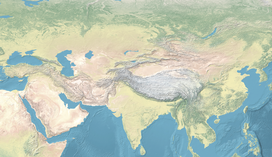
Back Tiensjan Afrikaans جبال تيان شان Arabic جبال تيان شان ARZ Tian Shan AST Tyanşan Azerbaijani تانری داغلاری AZB Тәңретау Bashkir Tian Shan BCL Цянь-Шань Byelorussian Тяншан Bulgarian
| Tian Shan | |
|---|---|
| Tengri Tagh, Tengir-Too, 天山 | |
 The Tian Shan range on the border of China, Kazakhstan and Kyrgyzstan with Khan Tengri (7,010 m) visible at center | |
| Highest point | |
| Peak | Jengish Chokusu |
| Elevation | 7,439 m (24,406 ft) |
| Coordinates | 42°02′06″N 80°07′32″E / 42.03500°N 80.12556°E |
| Geography | |
| Countries | |
| Range coordinates | 42°N 80°E / 42°N 80°E |
| Geology | |
| Rock age(s) | Mesozoic and Cenozoic |
| Official name | Xinjiang Tianshan |
| Type | Natural |
| Criteria | vii, ix |
| Designated | 2013 (37th session) |
| Reference no. | 1414 |
| Region | Asia |
| Official name | Western Tien-Shan |
| Type | Natural |
| Criteria | x |
| Designated | 2016 (40th session) |
| Reference no. | 1490 |
| Region | Asia |
The Tian Shan,[note 1] also known as the Tengri Tagh[1] or Tengir-Too,[2] meaning the "Mountains of God/Heaven", is a large system of mountain ranges in Central Asia. The highest peak is at the Jengish Chokusu at 7,439 metres (24,406 ft) high. Its lowest point is at the Turpan Depression, which is 154 m (505 ft) below sea level.[3]
The Tian Shan is sacred in Tengrism. Its second-highest peak is known as Khan Tengri, which can be translated as "Lord of the Spirits".[4] At the 2013 Conference on World Heritage, the eastern portion of Tian Shan in western China's Xinjiang Region was listed as a World Heritage Site.[5] The western portion in Kazakhstan, Kyrgyzstan, and Uzbekistan was then listed in 2016.[6]
Cite error: There are <ref group=note> tags on this page, but the references will not show without a {{reflist|group=note}} template (see the help page).
- ^ Prichard, James (1844). History of the Asiatic Nations. Vol. IV (3rd ed.). p. 281.
- ^ "Ensemble Tengir-Too". Aga Khan Trust for Culture. Archived from the original on 5 July 2019. Retrieved 5 July 2019.
- ^ Scheffel, Richard L.; Wernet, Susan J., eds. (1980). Natural Wonders of the World. USA: Reader's Digest Association, Inc. p. 378. ISBN 978-0-89577-087-5.
- ^ Wilkinson, Philip (2 October 2003). Myths and Legends. Stacey International. p. 163. ISBN 978-1900988612. Archived from the original on 14 January 2023. Retrieved 11 September 2016.
- ^ "新疆天山成功申遗". Archived from the original on 2013-06-27. Retrieved 2013-06-22.
- ^ "Western Tien-Shan". UNESCO World Heritage Centre. United Nations Educational, Scientific and Cultural Organization. Archived from the original on 7 July 2018. Retrieved 17 July 2016.

